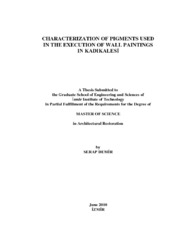Please use this identifier to cite or link to this item:
https://hdl.handle.net/11147/3815Full metadata record
| DC Field | Value | Language |
|---|---|---|
| dc.contributor.advisor | Böke, Hasan | - |
| dc.contributor.author | Demir, Serap | - |
| dc.date.accessioned | 2014-07-22T13:52:25Z | - |
| dc.date.available | 2014-07-22T13:52:25Z | - |
| dc.date.issued | 2010 | - |
| dc.identifier.uri | http://hdl.handle.net/11147/3815 | - |
| dc.description | Thesis (Master)--Izmir Institute of Technology, Architectural Restoration, Izmir, 2010 | en_US |
| dc.description | Includes bibliographical references (leaves: 79-84) | en_US |
| dc.description | Text in English; Abstract: Turkish and English. | en_US |
| dc.description | xii, 84 leaves | en_US |
| dc.description.abstract | Since prehistoric times wall paintings have been remarkable symbols of existences, identities, cultures and life-styles of human beings and societies and considerable integral parts of art and architecture. In this context, determination of painting techniques and materials employed and deterioration problems of the wall paintings, as of being part of built cultural heritage, have been crucial in terms of conservation. In this study, wall paintings existing in the Byzantine church-monastery edifice which have been uncovered in Kadıkalesi (Anaia) archaeological site were investigated for the purpose of identification of the original materials and painting technique. Mineralogical, chemical and micro-structural characteristic of the pigments and binding mediums employed in the fabrication of paintings; and basic physical properties, raw material compositions, mineralogical, chemical and micro-structural features of surface renderings underlying the painting layers were established. In the analyses, X-Ray diffraction (XRD), scanning electron microscope (SEM) equipped with energy dispersive X-ray spectroscopy (EDS), optical microscope, Fourier transform infra-red (FT-IR) spectroscopy and thermo-gravimetric analyzer (TGA) were used. On the basis of analyses results, it was determined that lime-secco technique was used in the fabrication of the investigated wall painting fragments; pigments were applied after mixed with lime (generally dolomitic lime) as binder on the surface of dry fine plaster. The density and porosity values of the fine plasters which paintings were executed are 1.20 g/cm3 and 40 % by volume respectively. The fine plasters were constructed with pure lime with small amount of soil material. Iron oxide-based pigments in red, yellow and purple paintings and aluminosilicate-based pigments; such as celadonite, glauconite in green paintings, lazurite and glaucophane in blue and dark blue paintings were employed. | en_US |
| dc.language.iso | en | en_US |
| dc.publisher | Izmir Institute of Technology | en_US |
| dc.rights | info:eu-repo/semantics/openAccess | en_US |
| dc.subject.lcsh | Mural painting and decoration, Ancient--Conservation and restoration | en |
| dc.subject.lcsh | Pigments--Testing | en |
| dc.subject.lcsh | Pigments--Preservation | en |
| dc.title | Characterization of Pigments Used in the Execution of Wall Paintings in Kadıkalesi | en_US |
| dc.type | Master Thesis | en_US |
| dc.institutionauthor | Demir, Serap | - |
| dc.department | Thesis (Master)--İzmir Institute of Technology, Conservation and Restoration of Cultural Heritage | en_US |
| dc.relation.publicationcategory | Tez | en_US |
| dc.identifier.wosquality | N/A | - |
| dc.identifier.scopusquality | N/A | - |
| item.openairetype | Master Thesis | - |
| item.cerifentitytype | Publications | - |
| item.grantfulltext | open | - |
| item.fulltext | With Fulltext | - |
| item.openairecristype | http://purl.org/coar/resource_type/c_18cf | - |
| item.languageiso639-1 | en | - |
| Appears in Collections: | Master Degree / Yüksek Lisans Tezleri | |
Files in This Item:
| File | Description | Size | Format | |
|---|---|---|---|---|
| T000846.pdf | MasterThesis | 8.84 MB | Adobe PDF |  View/Open |
CORE Recommender
Page view(s)
394
checked on Apr 7, 2025
Download(s)
120
checked on Apr 7, 2025
Google ScholarTM
Check
Items in GCRIS Repository are protected by copyright, with all rights reserved, unless otherwise indicated.